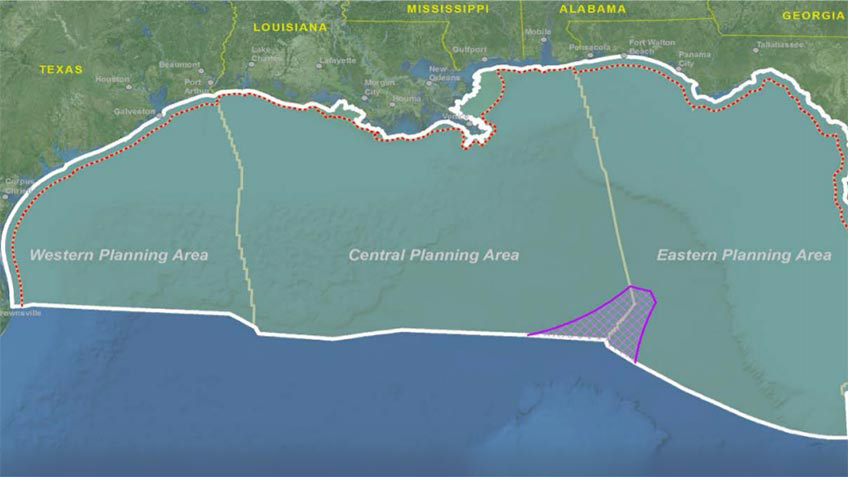The Leading Edge: May 2020 Wind Energy Newsletter
In this edition of The Leading Edge, we explore offshore wind energy in the Gulf of Mexico and take a look at hybrid wind and solar power plants.
News Stories
NREL Studies Determine Gulf of Mexico Well Positioned for Offshore Wind Development
Two recent studies conducted by NREL and funded by the Bureau of Ocean Energy Management have yielded promising results for the future of offshore wind energy in the Gulf of Mexico. The studies assessed potential offshore energy resources and determined which technologies are the most promising to meet the region's future energy needs. The results will inform national and regional strategic energy planning over the next decade.

Webinar Series Inspires Tomorrow's Wind Energy Innovators
The Wind Workforce Webinar Series places students and educators in a virtual classroom where they can connect with today's foremost experts in wind energy technologies, helping to prepare students for careers in the wind energy industry. The next webinar in the series, Grid Services from the Modern Wind Turbines: Engineering and Economics, will be led by NREL grid systems Principal Energy Analyst Paul Denholm and colleagues on May 19 at noon Mountain Daylight Time. For information on how to attend this meeting, please email Ram.Poudel@nrel.gov.
On the Radar
New Research Explores Opportunities for Hybrid Wind and Solar Power Plants
A new technical report titled Opportunities for Research and Development of Hybrid Power Plants summarizes state-of-the-art research concerning hybrid power plants. Hybrid power plants could provide significant value to the electric grid system as the share of renewable energies increase from 10% to 20% or more and costs of wind, solar photovoltaics, and battery storage continue to decrease.
The report covers resource and market opportunities, technology selection and sizing, physical design, and operation and control of hybrid power systems.
NREL researchers are developing analysis and optimization tools to help design more cost-efficient and grid-friendly renewable energy plants by taking advantage of the benefits of hybridization. Learn more by visiting Hybrid Energy Systems Research.
FLORIS 2.0
Wind farm controls researchers released an enhanced version of FLOw Redirection and Induction in Steady State (FLORIS), available now for download. NREL researchers use FLORIS to analyze wind farm control theory and to design and analyze field validation campaigns. Developed in collaboration with the Delft University of Technology, FLORIS provides a computationally inexpensive, controls-oriented modeling tool of steady-state wake characteristics in a wind farm. Recent improvements include:
- Enabling heterogeneous inflow at a wind farm so that incoming wind can vary spatially in terms of wind speed, direction, and turbulence
- Setting the new Gauss-Curl Hybrid Model as the default wake-steering model, along with several other improvements that enhance optimization methods and wake modeling
- Improving optimization methods and wake model modularization
- Enhancing default-model tuning to improve model accuracy in validation studies.
To receive periodic updates on FLORIS, or for more details on using or contributing to the FLORIS open-source framework, please email paul.fleming@nrel.gov.
Downwind – In Case You Missed It
Distributed Wind Could Play Role in Microgrids Market
An article by GreenTech Media covers some future opportunities for distributed wind brought about by cheaper turbine models, increased demand from the growing microgrid market, and an intensifying focus on distributed energy resources. The article references Microgrids, Infrastructure Resilience, and Advanced Controls Launchpad (MIRACL), a new U.S. Department of Energy multilab research initiative led by NREL that seeks to integrate wind into microgrids and hybrid power systems alongside solar, storage, and other distributed energy resources. Learn more about MIRACL by downloading the MIRACL fact sheet.
Publications
Report of the Condition of a General Electric Transportation Systems Gearbox
As the first step in a new research effort to investigate gear-tooth micropitting, this report documents the micropitting damage observed in a General Electric Transportation Systems wind turbine gearbox. This information will be used in an upcoming case study of the ISO/TS 6336-22 micropitting safety factor method when applied to gear sets and applications that have experienced micropitting in the field. Wind power plant operation and maintenance costs remain a substantial contributor to the overall cost of wind energy, and a significant percentage of wind turbine operation and maintenance costs comes from premature gearbox failures caused by micropitting.
Share

